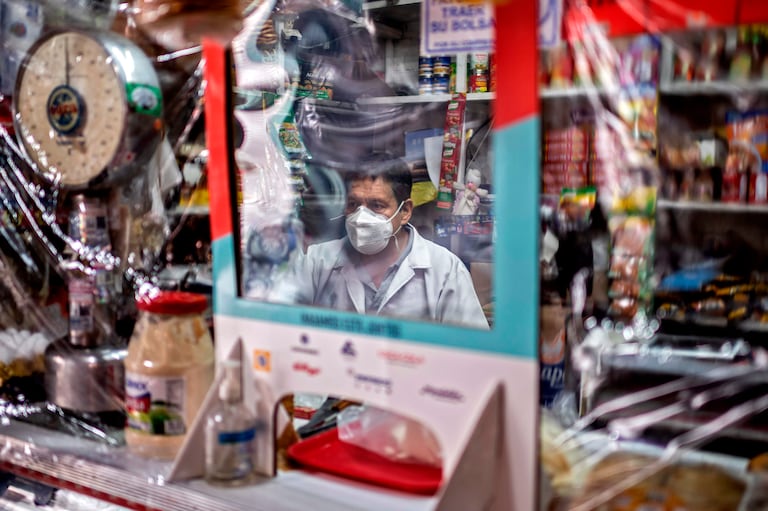The economic collapse due to the coronavirus will be deeper than expected but the recovery will be earlier. The Bank of Mexico foresees a fall of up to 12.8% for this year, four points more than in the previous projection, and a modest recovery for 2021, according to the quarterly report released this Wednesday. However, the institution sees a "high degree of uncertainty" due to the still unknown duration of the pandemic and possible outbreaks. The projections are on the back of a historically bad second quarter. Between April and June, GDP fell by 18.7% annually, the largest reduction since there are records, although economic activity experienced a rebound in June with the start of the reopening, as published on Wednesday by the National Institute of Statistics and Geography (Inegi).
The Bank's projections exude caution. "We are in an area of which there is no precedent," said the governor, Alejandro Díaz de León, during the presentation of the report. Instead of a central scenario, the institution has presented three possible ones. At the most favorable, the contraction would be 8.8% and at the worst, 12.8%. They are less optimistic forecasts than those presented in May, when the projected falls ranged from 4.6% to a maximum of 8.8%. The deterioration points to a difficult second semester despite the gradual reopening of activities and the fiscal and monetary measures adopted by the Government and the Bank itself. "It would imply an even more negative environment in the second semester than the one experienced in the first with the confinement and that the measures have not been sufficient to relaunch the economy," says economist José Luis de la Cruz.
In the second quarter of the year, when non-essential activities were suspended, the Mexican economy plummeted 18.7% in annual terms and 17.1% compared to the first three months of the year. The quarterly figure, which represents a slight downward revision compared to the preliminary data published at the end of July, represents the fifth consecutive quarterly decline. In 2019, before the outbreak of the virus, the economy had already contracted 0.1%. The slowdown in the United States, the main destination for Mexican exports, and the uncertainty in Mexico due to regulatory changes in key sectors such as energy already weighed on growth.
The quarterly collapse is much higher than in previous crises. Until now, the worst setback had occurred in the second quarter of 1995, when the devaluation of the peso and the massive flight of capital caused a drop of 8.6% compared to the same period of the previous year. In the second quarter of 2009, when the double effect of the global financial crisis and the AH1N1 influenza was felt in Mexico, GDP fell 7.7%. Díaz de León has pointed to one of the greatest vulnerabilities of the economy in the face of the current shock: “Mexico had the greatest contraction in industrial production and, in particular, manufacturing. It is a very open economy and integrated to the American one. The production stoppage in some of these sectors had a very significant consequence ”.
Despite the historic crash, there are signs that rock bottom is already hitting. Banco de México forecasts growth rates of between 1.3% and 5.6% for 2021, an improvement over its previous projections. In June, the first month of the gradual reopening, economic activity grew 8.9% compared to May, according to Inegi published this Wednesday. Industry was the one that experienced the greatest jump, with a 17.9% rebound after the stoppage that occurred with the declaration of emergency. The services sector advanced 6.2%. All in all, the activity in June is still 14.5% lower than in the same month in 2019. This points to a recovery with a long road ahead. “The June figure I wouldn't call it a recovery. The reopening has reactivated certain productive sectors, but they are not enough to generate growth compared to last year, ”says De la Cruz.
The response of the Government of Andrés Manuel López Obrador to the crisis has consisted mainly in granting microcredits to small companies and in reinforcing existing social programs, a plan that is far from the level of spending of the large economies of the region. The Executive will soon present an agreement, paralyzed for months, for the development of infrastructure, the details of which have not yet been revealed. "We would like to get out of the crisis soon, we are already recovering, workers are already being rehired and we are going to leave without over-indebtedness, because in other countries - not to brag - they got out of hand," he declared this Wednesday. In support of the recovery thesis, the president assures that, after losing more than a million formal jobs in the previous five months, some 30,000 jobs had been created by mid-August, a figure that has not yet been officially published .
The Bank of Mexico has emerged as an important actor to soften the blow of the crisis. It has lowered interest rates to 4.5%, the lowest level in four years, and has announced measures to promote credit for a value of 800,000 million pesos. An important part, 250,000 million pesos, was destined to encourage commercial banks to finance medium and small companies. So far, only 175,000 of the total amount have been used. Despite this low utilization, Díaz de León has highlighted the benefits of the advertisement. "Not only is the amount of use of the measures important, but also the announcement of the same," he said. The opening of liquidity windows has made commercial banks "less reluctant to finance and grant financing", he assured.

